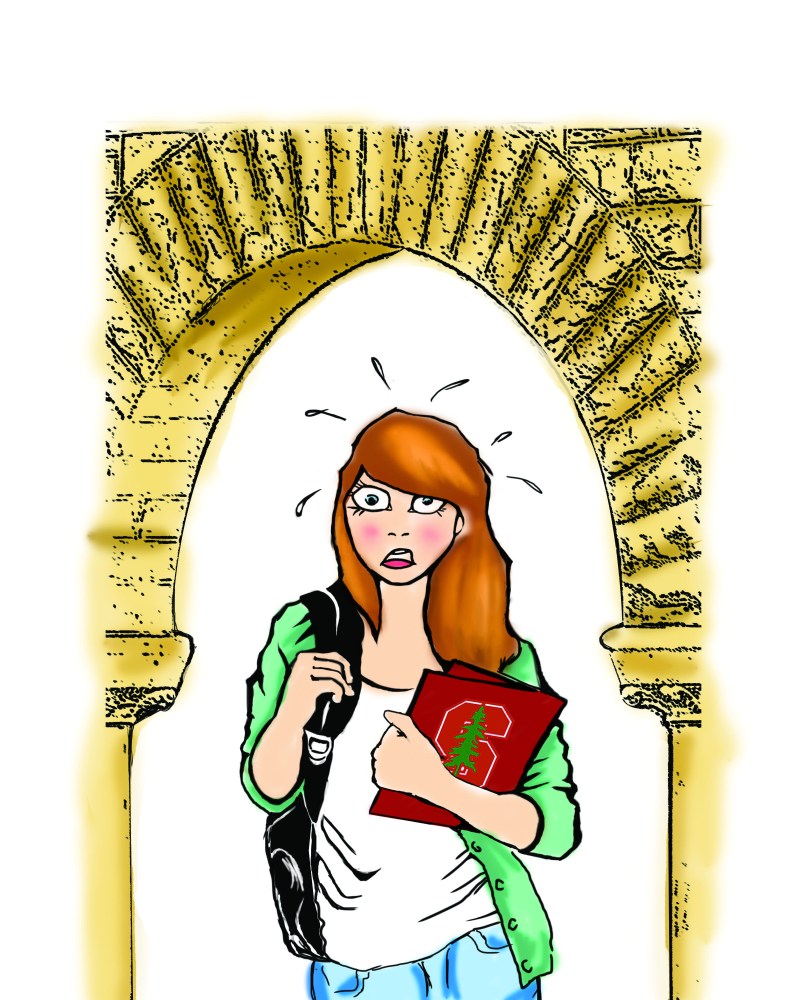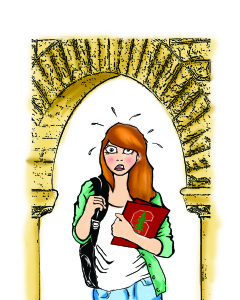We asked Daily staffers about the best classes they’ve ever taken during fall quarter, and this is the list of goodies — some well known, some obscure — that we came up with. Some of them are intro classes whose lessons have given us a lot of mileage in our studies, others are cleverly designed IntroSems and still others are upper-level seminars but very approachable for freshmen.
AMSTUD 132/ARTHIST 132: American Art and Culture, 1528 to 1850
Tue., Thu. 9:00 – 10:30 a.m., 4 units, Bryan Wolf
GERs: DB-Hum, EC-AmerCul, WAY-AII
What makes Bryan Wolf’s class on early American art and thought great is not so much the mastery of the artists or writers themselves (colonial portraiture is certainly nothing to write home about), but the deft way in which Wolf weaves cultural themes together through these distinct objets d’art. On top of exposing you to a diverse range of artistic styles from America’s early years, this course will enable you to go into an art museum and bust out facts about some of our nation’s finest painters: John Singleton Copley’s breakthrough painting was of a mischievous squirrel, Charles Willson Peale built the first natural history museum in the country and members of the Hudson River School would paint their landscapes of the Catskills mountains months after they left the wilderness. Wolf knows his art, and his enthusiasm for the subject radiates beyond the confines of his PowerPoint presentations.
ARCHLGY 1: Introduction to Prehistoric Archaeology
Mon., Wed., Fri. 9:00 – 9:50 a.m., 3-5 units, John Rick
GERs: DB-SocSci, EC-GlobalCom, WAY-AII, WAY-SI
If you were ever fascinated by mummies or pretended to be a hunter-gatherer in your backyard, this is the class for you! Indulge your inner archaeologist and learn the basics of the field in this intro class taught by Professor John Rick, who walks you through the development of prehistoric human society and the methods used to discover the past. Rick is an engaging lecturer, but the best part of this class is actually the assignments, which give you the chance to make sense of real(ish) archaeological data. Sections are also exciting, with a hands-on lab component (you even get to create your own stone tool!). This class will convince a few of you to delve deeper into the tiny but wonderful archaeology department and, for the rest, allow you to play Indiana Jones for a quarter.
ATHLETIC 2: Abs and Glutes
Mon., Wed. 11:00 – 11:50 a.m., 1 unit, Nancy Conniff
Keep the freshman 15 away with instructor Nancy Conniff, whose enthusiasm is contagious — she’s the female version of Richard Simmons, minus the rhinestone leotards. She gradually introduces more difficult moves and exercises throughout the quarter but never pushes her students beyond their comfort zones. And if you manage to stick with the course through midterms and up till Finals Week, you’ll get at least a four pack, though you might need some help explaining away Abs and Glutes on your transcript in a job interview.
ATHLETIC 164: Volleyball: Intermediate Sand
Mon., Wed. 1:15 – 2:05 p.m., 1 unit, Don Shaw
Take advantage of those new sand volleyball courts behind Stern Hall with some classes with Coach Shaw, who led the Stanford women’s volleyball team to four NCAA titles between 1984 and1999. Coach combines a short lesson at the beginning of class with a lot of playing time — skill level in the Intermediate class includes beach regulars, converted indoor players and even newcomers whose only volleyball experience is peppering at a barbecue. Those afraid of the cold should wait until spring to take this class — by the time November rolls around, it’s going to be pretty chilly out there.
BIO 15N: Environmental Literacy
Tue., Thu. 2:15 – 3:30 p.m., 3 units, Terry Root
GERs: DB-NatSci, WAY-SMA
You may find Terry Root’s face familiar on your first day: her portrait is on the wall at CoHo. Her IntroSem, an introduction to climate change science with an emphasis on policy literacy, revolves around student questions prepared for a couple short readings. One of the greatest perks of this class is learning about climate change negotiations from an inside source: Root shared the 2007 Nobel Peace Prize for her work with Al Gore and the International Panel on Climate Change.
BIO 34N: Hunger
Tue., Thu. 4:15 – 5:30 p.m., 3 units, Kathryn Barton
GER: DB-NatSci
If you’re looking for an interesting class that won’t take up a lot of your time and is also an easy A+ (yes, A+), take this IntroSem. Rather than focusing on biology, the course has a historical focus on the topic of hunger, including causes and consequences of past major famines. At times, Professor Kathryn Barton tried to introduce some of the in-depth science behind food biotechnology, but most of the students — the non-pre-med ones — had none of it and instead drove the seminar discussion towards the societal impacts of hunger, which was a relief. That being said, Professor Barton is so knowledgeable about the subject and always eager to talk with students about their academic interests. The weekly readings are light, and the only major task you have for the entire quarter is to give a 10-minute presentation on a crop assigned by the instructor.
BIOE 44: Fundamentals for Engineering Biology Lab
Tue., Thu. 11:00 – 11:50 a.m., 4 units, Joseph Shih and Andrew Endy
GERs: WAY-SMA
This class will rock your world if you’re interested in biology, biotechnology, chemical engineering or just crazy cool applications of life science technology. BIOE 44 is the introductory lab class for the bioengineering major, but it is open and very accessible to non-majors. I like to think of this class as genetic engineering 101. In 10 weeks, you will learn all the tools needed to create and test your own genetically encoded device as part of a useful biological product. For example, a successful project last year included the development of a mercury ion detoxification system in E. coli. Professors Endy and Shih work hard to bring all students up to speed in biotechnology principles and skills needed to develop unique and exciting genetic engineering projects.
CS 106A/ENGR 70A: Programming Methodology
Mon., Wed., Fri. 3:15 – 4:05 p.m., 5 units, Mehran Sahami
GERs: DB-EngrAppSci, WAY-FR
CS 106A, the most ubiquitous Stanford course, is a great way to decide whether computer science is for you. The energetic Mehran Sahami, one of Google’s first engineers, teaches the course every fall and is filled with infectious energy for the subject and teaching in general. The course gives you great insight into basic coding, and you walk away with a much better understanding of how computer programs actually work: Lessons include simple introductions to arrays, and strings and basic computer commands are covered. If you find the assignments and exams easy, you’ll probably be a good fit for computer science, but if you find the material to be challenging, be warned — CS 106A is child’s play for computer science students.
INTNLREL 1/POLISCI 1: Introduction to International Relations
Mon., Tue., Wed. 11:00 – 11:50 a.m., 5 units, Michael Tomz
GERs: DB-SocSci, WAY-AQR, WAY-SI
You can’t find another class that covers as much material in as organized and digestible a way. This class explores a broad range of international relations problems in four short sections: war, trade, the environment and humanitarian aid. It’s also an overview of general social science thinking for non-majors curious about political science. Professor Mike Tomz, a winner of the Karl Deutsch Award for the most significant contribution to the field of international relations within 10 years of earning a Ph.D., was also a high school policy debate champion — he never says “um” and uncannily finishes lecture at 11:49.
ME 101: Visual Thinking
Mon., Wed. 1:15 – 3:05 p.m., 4 units, David Northway
GERs: DB-EngrAppSci
If you want a quick and dirty intro to design and building stuff, this is the class for you. It meets twice a week for two-hour stretches, with coursework consisting of building three design projects over the course of the quarter. There’s no escaping the elephant in the room, which is that the second project will take over your life, probably forcing you to break up with your girlfriend and abandon sleep for a few weeks. The plus side is that the class is really interesting and has no exams at all, only the three projects and their associated design logbooks. It’s a little tough for freshman to get in, but hey, you never know unless you try.
SOC 155/FEMGEN 155: The Changing American Family
Tue., Thu. 11:00 – 11:50 a.m., 5 units, Michael Rosenfeld
GERs: DB-SocSci, EC-AmerCul, WAY-ED, WAY-SI
It’s no secret that family life provides much of the fodder for film and fiction, from television sitcoms to indie dramas. Michael Rosenfeld’s course tracks the trends in American family demographics throughout the nation’s history, touching on changes in patterns of marriage, cohabitation, childrearing and divorce. Unlike other sociology classes that feature dense texts weighed down by demographic facts and figures, Rosenfeld’s literature of choice — including a book of his own — is replete with anecdotal asides, the historical background behind many of those changes and personal accounts of representative — and unique — American families. And two 50-minute lectures a week for a 5-unit class is not too shabby, either.

